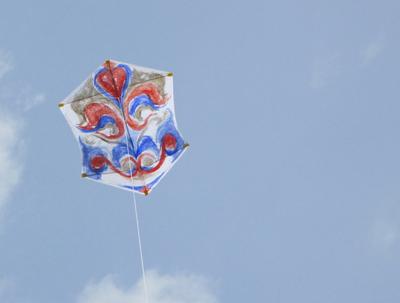2-Skewer Rokkaku Kite:
My First and Favorite
by MBK Flight Reporter: Susan Drey
(Omaha, NE, USA)

Close up with beautiful blue sky
I began my new journey into kite making and flying at the beginning of May, 2013. And this Rokkaku is the first kite I made.
I thought the Rokkaku looked to be the most beautiful of the simpler kites, so I decided to start with it. I did a bit of research on sail materials and ended up using a paper made from bark, ‘Lokta’, which I painted with acrylics.
So, now the FLIGHT report begins:
I first flew this kite four weeks ago and it rose quite easily with very little wind. So this evening, with very mild winds, I ventured over to my neighboring park and let it go. But, at the beginning I had to deal with a couple of nose dives. After which, I remembered to adjust the prusik knot, moving it a little closer to the nose (top of the kite), which followed with success. The wind was so calm (maybe 5 to 7mph), that I don’t believe I could have flown any other kite in this very mild wind.
(A note to readers... The e-book "Making Skewer Kites" will be handy if you decide to have this kind of experience for yourself one day - Tim P.)
The kite rose easily on the gentle wind, although there were a couple of moments when it started to waft and fall – almost laying flat at times, dipping downward at rapid angles. But, it finally gained enough height to where the winds were more constant, at about 100 feet. At that height it held steady, and even when it faltered, a new wind would come along and rescue it to new heights.
I believe it was out about 150 to 200 feet, when the flight really smoothed out and all problems dissipated.
I eventually let the Rok out to about 450 feet and it pulled hard and strong. Sometimes there was a big sag in the line, and other times the line would pull extremely taught and rise almost directly overhead.
But when the Rok got to that point of being right over my head, it would often start to falter and flail, and even tumble. I believe it had risen to too high an angle for the wind to sustain. So when it reached that zenith it would soon begin to plummet at huge intervals, until another wind picked it up and sent it soaring up to even greater heights.
The kite was extremely hard to view much of the time, as it was directly in front of the setting sun. This was about 6:30 pm, and the sun was about 60 degrees above the horizon. The wind was out of the East which directed the kite right at the sun.
But, when it did rise to that 80 or 90 degree angle (higher than the setting sun), or moved further to the south or north of the sun, it was quite lovely.
And I will say that the colors (dark and light blue and orange) of this kite were very beautiful against the sky. And, the sun coming through the transparent paper was extremely beautiful.
This kite’s steady ascent towards the sun reminded me of the fable of lcarus, as he flew with his wax wings too close to the sun, and then his wings melted.
I thought I would take some close up photos when I pulled in my Rokkaku, but once it was below 75 feet, it just laid flat and fell to the earth. This kite does so well in light winds, but really needs to rise above 75 feet before it is stable and committed to staying aloft.
Download the e-book "Making Skewer Kites" here.
Return to MBK Flight Reporter Submission.
As mentioned earlier, there's more kite making on this site than you can poke a stick at. :-)
Want to know the most convenient way of using it all?
The Big MBK E-book Bundle is a collection of downloads—printable PDF files that provide step-by-step instructions for many kites large and small.
That's every kite in every MBK series.







